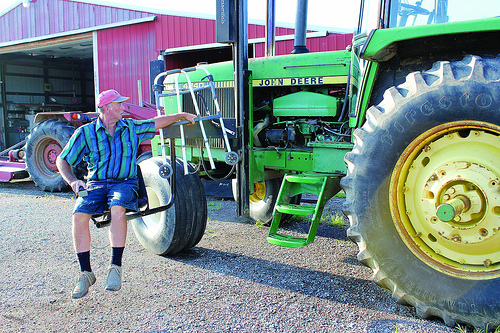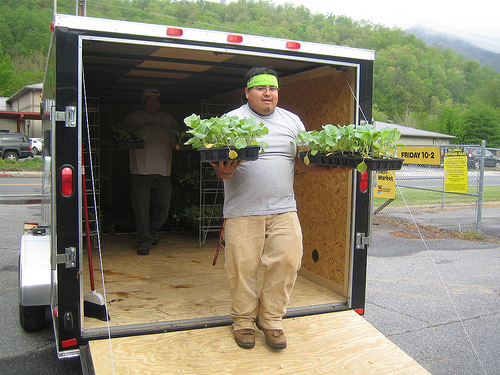
Family of three dines outdoors. ERS research found that among households that included an adult with a work-preventing disability, a third were food insecure in 2009-10.
This post is part of the Science Tuesday feature series on the USDA blog. Check back each week as we showcase stories and news from USDA’s rich science and research portfolio.
In 2011, close to 15 percent of U.S. households had trouble meeting their food needs. This phenomenon is known as food insecurity, and it means that at some time during the year, these households lacked adequate food for one or more household members due to insufficient money or other resources for food. Read more »

Mark Hosier, paralyzed from the waist down, uses a mechanical lift to board his tractor. Hosier works with the NIFA-funded AgrAbility Program to overcome disabilities and continue working as an agricultural producer. Photo courtesy of National Swine Registry/Seedstock EDGE.
Although Mark Hosier was told he’d never walk again, the Indiana farmer is running a 500-acre farm and 10-sow showpig business entirely on his own. Injured in 2006 when a 2,000-pound hay bale rolled off his tractor on top of him and crushed two vertebrae, Hosier thought he wouldn’t be able to continue farming. Today, he operates his tractor with the help of a mechanical lift; modifications to his facilities allow him to care for his hogs from a wheelchair. Read more »

Christopher and Natasha Goetz preparing dinner in their home in Garnett, Kansas. By 2005-08, total fat accounted for 30.5 percent of calories in foods prepared at home, compared with 37 percent in away-from-home foods.
This post is part of the Science Tuesday feature series on the USDA blog. Check back each week as we showcase stories and news from USDA’s rich science and research portfolio.
With restaurant and take-out meals an everyday occurrence for many, the choices we make when eating out can have a big impact on our health. Federal surveys find that Americans, on average, get 32 percent of their calories from foods ordered from restaurants, fast food places, and other away-from-home sources, up from 18 percent of calories 30 years ago. Read more »
This post is part of the Science Today feature series on the USDA blog. Check back each week as we showcase stories and news from USDA’s rich science and research portfolio.
Chances are that among many of the Americans who made a New Year’s resolution, nutrition figures somewhere in their goal. They may be aiming to shed a few pounds, or opt for a healthier diet, or perhaps they’re going for the whole package of a healthier lifestyle encompassing both diet and exercise.
While it’s not exactly a New Year’s resolution, a group of federal agencies is making a fresh start this month with the Interagency Committee on Human Nutrition Research (ICHNR), co-chaired by Dr. Catherine Woteki, USDA Chief Scientist and Under Secretary for Research, Education and Economics, and Dr. Howard Koh, Assistant Secretary for Health in the Department of Health and Human Services. The committee was chartered in 1983 and will be reestablished in 2013. Read more »

Volunteer George Welch unloads Garden Wagon plants.
When members of the Eastern Band of Cherokee Indians can’t make it to their local extension office, their extension office comes to them—with a gift of better health through home gardening. Read more »

A new report by the Economic Research Service reveals that between 1998 and 2006, U.S. households spent an average of just 0.5 percent of their food budgets on vegetables, excluding potatoes, compared with the USDA-recommended 7 percent. (Photo: Thinkstock)
This post is part of the Science Tuesday feature series on the USDA blog. Check back each week as we showcase stories and news from USDA’s rich science and research portfolio.
Many of our diets aren’t what they should be. Americans eat fewer fruits and vegetables than Federal nutrition guidance recommends, and we over-consume fats, added sugars, and refined grains. Health professionals warn us that the less-healthful food choices are showing up on our waistlines and in our health, contributing to increasing cases of overweight and obesity, cardiovascular disease, and diabetes. Knowing how far we stray from good dietary patterns, and whether the diets of certain segments of the population are more misaligned, can help in designing more effective programs and consumer education. Read more »





